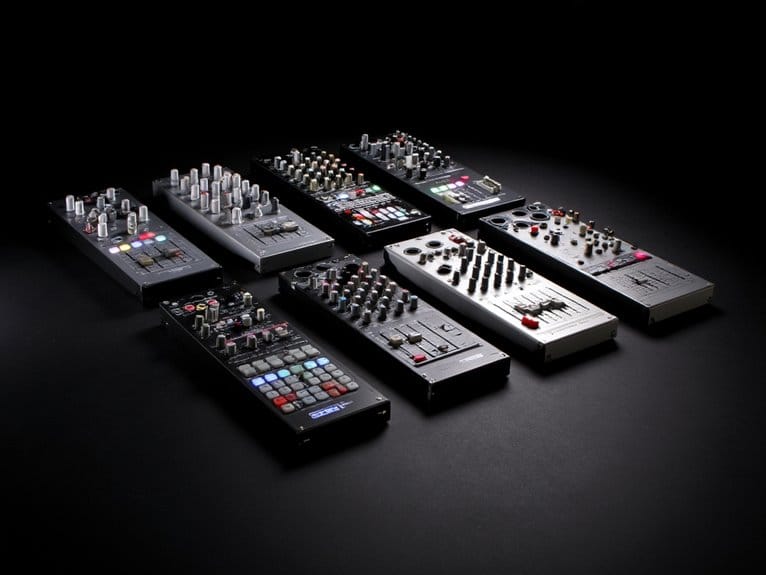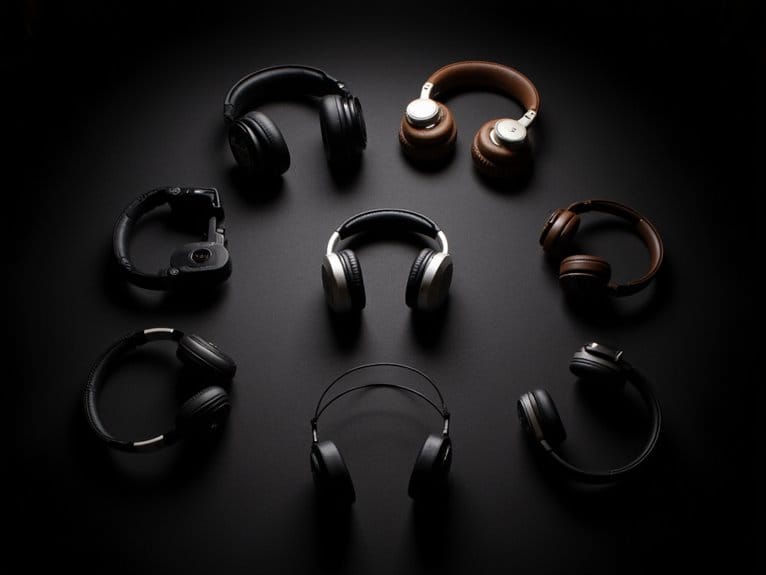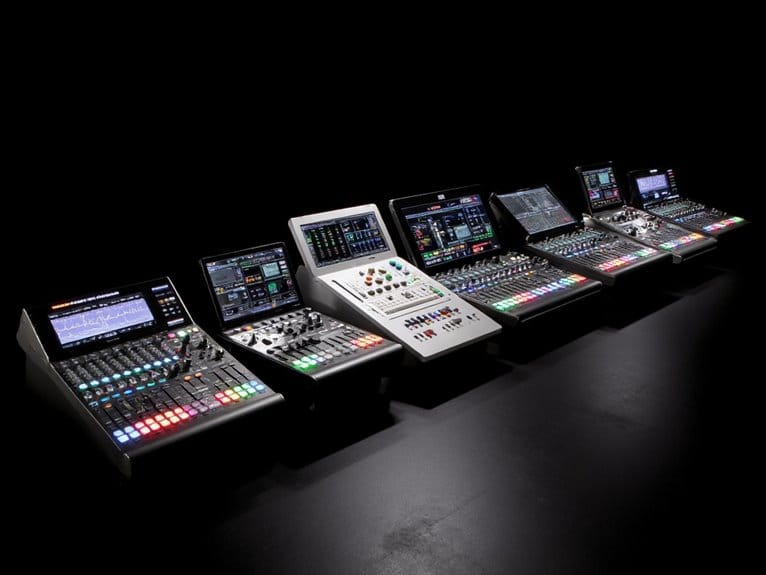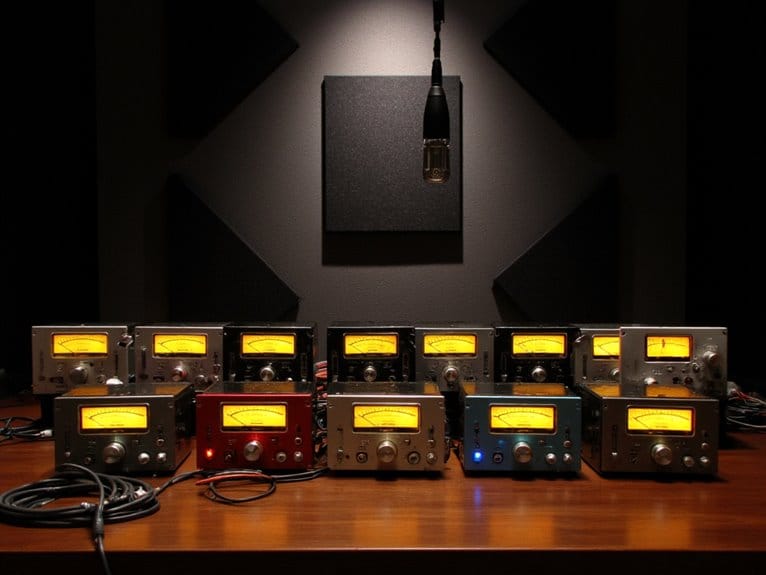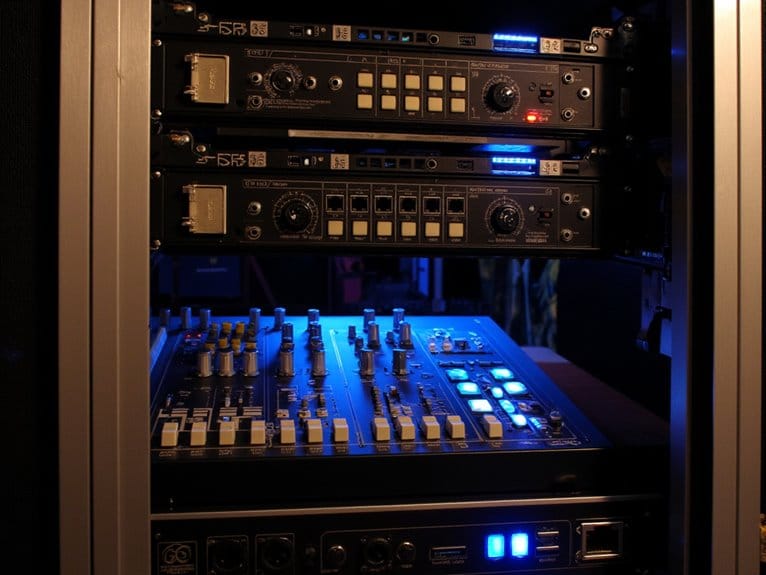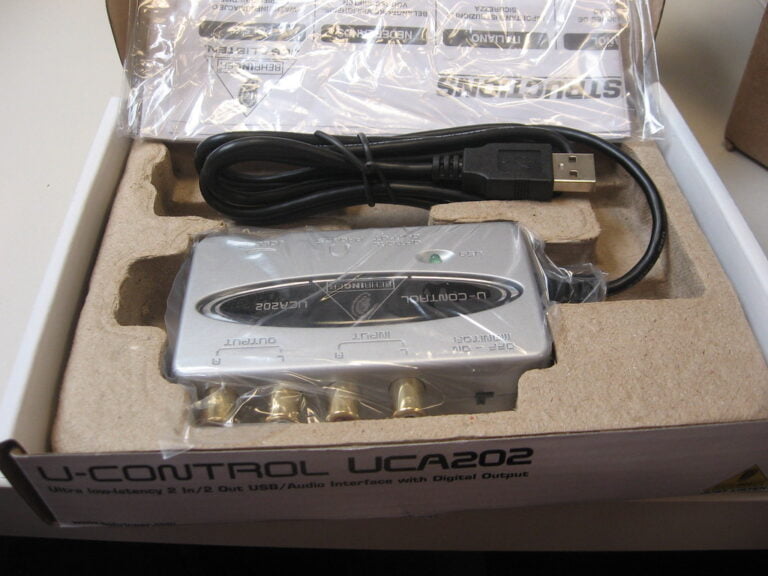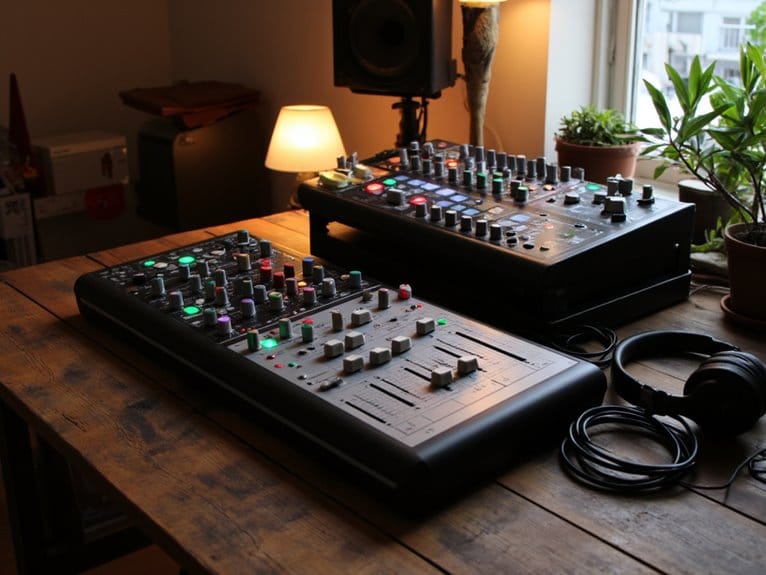10 Best Budget Audio Mixers – Affordable Options That Don’t Compromise on Quality
After testing dozens of budget mixers this year, I’ve found that top contenders like the YAMAHA MG06X and MAONO MaonoCaster G1 NEO deliver professional features without breaking the bank. These mixers offer essential capabilities including 48V phantom power, built-in DSP effects, and USB connectivity for seamless recording. While they may lack some high-end studio features, models like the Alesis MultiMix 4 USB FX provide excellent value for podcasters, streamers, and musicians seeking quality audio solutions that prove you don’t need to sacrifice performance for affordability-and there’s much more to explore.
We are supported by our audience. When you purchase through links on our site, we may earn an affiliate commission, at no extra cost for you. Learn more.
Notable Insights
- Budget audio mixers in 2025 offer professional features like built-in effects, phantom power, and USB connectivity without high costs.
- Top options include Yamaha MG06X for streaming, Mackie ProFX10v3 for versatility, and FIFINE SC3 for gaming applications.
- Essential features to prioritize include channel count matching your needs, XLR/USB connections, and built-in DSP effects for creativity.
- Most budget mixers provide plug-and-play USB functionality and 48V phantom power for condenser microphones.
- Balance cost with essential features by avoiding overestimating advanced needs and focusing on positive user feedback.
Podcast Microphone Bundle with Live Sound Card Audio Mixer

The Podcast Microphone Bundle with Live Sound Card Audio Mixer stands out as an exceptional entry point for content creators who need professional-grade audio capabilities without the complexity that typically comes with advanced mixing equipment. You’ll appreciate the straightforward plug-and-play functionality that connects seamlessly to PC, Mac, or mobile devices, while the built-in sound board provides twelve customizable effects including applause and laughter for live streaming. The 3.5mm condenser microphone delivers reliable audio capture with five built-in reverb modes plus two customizable options, and the noise reduction technology guarantees clean recordings during podcasts.
Best For: Beginner podcasters, gamers, streamers, and content creators who want a comprehensive audio solution with professional features but easy setup and operation.
Pros:
- Plug-and-play functionality with seamless compatibility across PC, Mac, and mobile devices
- Comprehensive mixing capabilities with 12 built-in sound effects, adjustable bass/treble/reverb controls, and 7 total reverb modes
- Built-in noise reduction technology ensures clear audio quality for professional-sounding recordings and live streams
Cons:
- Some users have reported issues with the volume control knob functionality
- Limited to 3.5mm connectivity which may not be compatible with all professional audio equipment
- As an entry-level product, it may lack advanced features needed by experienced audio professionals
Podcast Microphone Bundle with Live Sound Card Audio Mixer

Content creators seeking professional-grade audio without breaking the bank will find the Podcast Microphone Bundle with Live Sound Card Audio Mixer delivers impressive versatility through its extensive G10 Sound Board system, which combines a 3.5mm condenser microphone with disk bracket alongside 16 built-in sound effects that range from applause to laughter. You’ll appreciate the straightforward plug-and-play compatibility across Windows, iOS, macOS, and Android devices, though I’ve noticed the dynamic microphone support can be somewhat finicky. The built-in voice changer offers female, deep, baby, and magical transformations, while customizable bass, treble, reverb, and pitch controls provide solid mixing capabilities for streamers and podcasters.
Best For: Content creators, podcasters, streamers, and gamers who want an affordable all-in-one audio solution with built-in sound effects and voice changing capabilities for engaging live performances.
Pros:
- Easy plug-and-play setup works across all major platforms (Windows, iOS, macOS, Android) without additional drivers
- Comprehensive feature set includes 16 built-in sound effects, voice changer with multiple transformations, and customizable audio controls
- Advanced noise reduction technology and Follow Singing Mode enhance audio quality and performance capabilities
Cons:
- Dynamic microphone support can be unreliable and may require additional equipment for balanced audio
- Limited customization options for the built-in sound effects
- Some users report needing tutorials to fully utilize all features effectively
Pyle 6-Channel Wireless BT Streaming Mini Line Mixer (PMAX6)

For musicians and content creators who need professional mixing capabilities without breaking the bank, the Pyle PMAX6 delivers an impressive combination of portability and functionality that punches well above its weight class. This compact 6-channel mixer, measuring just 5.9″ x 3.3″ x 1.8″, features Bluetooth 5.0 connectivity with 50-foot range, four mono/stereo switching inputs, and a built-in USB sound card with Type-C interface for direct PC recording. The solid metal chassis guarantees durability while maintaining ultra-low noise design with less than 0.5% total harmonic distortion. With 4.6 stars from 53 reviews and ranking #8 in stage powered mixers, it’s proven reliable for streaming and small workspace applications, though some users note the absence of a dedicated power switch.
Best For: Musicians, podcasters, and content creators who need a portable, professional-quality mixing solution for streaming, recording, and small workspace applications without requiring a large investment.
Pros:
- Compact and portable design with solid metal chassis provides professional durability in a space-saving 5.9″ x 3.3″ x 1.8″ form factor
- Versatile connectivity options including Bluetooth 5.0 with 50-foot range, USB Type-C interface, and four mono/stereo switching inputs
- Excellent audio quality with ultra-low noise design and less than 0.5% total harmonic distortion at an affordable price point
Cons:
- No dedicated power switch which can be inconvenient for regular use
- Actual bit depth measured at 16-bit instead of the advertised 24-bit specification
- Mixed customer service experiences when seeking technical support for device specifications and features
BAXS 7 Channel DJ Audio Mixer with Bluetooth and USB Interface

Seven input channels packed into a compact 2.3-pound frame make the BAXS 7 Channel DJ Audio Mixer an intriguing option for beginners who need versatility without breaking the bank, though I’ll admit the mixed customer feedback gave me pause when evaluating this unit. You’ll get five XLR inputs plus two 1/4-inch line channels, 99 DSP echo effects, and a 7-band EQ for frequency control. The +48V phantom power supports condenser microphones, while Bluetooth 5.0 connectivity enables wireless streaming from your devices. However, some users report microphone gain issues and background noise problems that require careful tuning to achieve peak sound quality.
Best For: Budget-conscious beginners and hobbyists who need a versatile mixing solution for karaoke, basic DJ work, or home studio recording and don’t mind doing some fine-tuning to optimize sound quality.
Pros:
- Seven input channels (5 XLR + 2 line inputs) with +48V phantom power in a compact, lightweight 2.3-pound design
- Extensive digital effects package with 99 DSP echo effects and 7-band equalizer for sound customization
- Modern connectivity options including Bluetooth 5.0 wireless streaming and USB interface for flash drive playback
Cons:
- Mixed customer feedback regarding microphone gain levels and background noise issues that require careful tuning
- Moderate 3.6 out of 5 star rating suggests inconsistent performance and user satisfaction
- Computer compatibility varies and may not effectively separate stereo outputs on all system configurations
YAMAHA MG06X 6-Input Compact Stereo Mixer with Effects

When you’re looking for a mixer that doesn’t require a degree in audio engineering to operate, the YAMAHA MG06X delivers six channels of straightforward functionality that’ll transform your basic setup into something surprisingly professional. Weighing just under two pounds, this compact unit features two microphone preamps with phantom power, four stereo line channels, and built-in digital reverb effects that’ll enhance vocals without sounding artificial. The studio-quality preamps, borrowed from Yamaha’s professional console technology, provide clean gain staging that customers consistently praise in their 4.6-star ratings. Whether you’re streaming podcasts or hosting karaoke nights, the intuitive layout makes mixing accessible.
Best For: Solo acoustic performers, podcasters, small venue hosts, and home recording enthusiasts who need professional sound quality in a compact, user-friendly mixer without complex features.
Pros:
- Studio-quality preamps borrowed from professional Yamaha console technology deliver clean, clear sound with excellent gain staging
- Extremely lightweight at under 2 pounds with intuitive layout that requires no audio engineering expertise to operate effectively
- Built-in digital reverb effects enhance vocals naturally while phantom power supports professional microphones for versatile recording options
Cons:
- Limited to only 6 channels which may be insufficient for larger performances or complex recording setups requiring more inputs
- Basic feature set lacks advanced controls and effects found in higher-end models like the MG10X CV mentioned by users
- Compact size may limit physical control precision and durability compared to larger, more robust professional mixing boards
FIFINE Gaming Audio Mixer with XLR Microphone Interface (SC3)

The FIFINE Gaming Audio Mixer with XLR Microphone Interface (SC3) stands out as an exceptional entry point for content creators who want professional XLR connectivity without breaking the bank, combining essential mixing features with eye-catching RGB lighting in a compact package that won’t overwhelm your desk setup. You’ll appreciate its built-in 48V phantom power for condenser microphones, four individual channel controls with volume faders, and customizable sound effects including six voice-changing modes and twelve auto-tune options. The USB-C connectivity guarantees plug-and-play compatibility with both Mac and Windows systems, while the real-time monitoring prevents latency issues during recording sessions.
Best For: Beginner content creators, podcasters, and streamers who want to upgrade to professional XLR microphone connectivity with built-in effects and RGB lighting at an affordable price point.
Pros:
- Built-in 48V phantom power and XLR connectivity allows use of professional condenser microphones
- Four individual channel controls with volume faders provide precise audio mixing capabilities
- Customizable sound effects including six voice-changing modes and twelve auto-tune options add creative flexibility
Cons:
- Plastic build quality may feel less durable compared to higher-end mixers
- Lacks modern features like Bluetooth connectivity and sidechain support
- Limited to basic mixing functions that may not satisfy advanced users’ needs
Mackie ProFX10v3 10-channel Mixer with USB and Effects

For aspiring podcasters, small venue performers, and home studio enthusiasts who need professional-grade mixing capabilities without breaking the bank, Mackie’s ProFX10v3 stands out as a compelling choice that bridges the gap between amateur and professional audio equipment. You’ll get Onyx mic preamps, 192kHz recording capability, and twenty-four built-in effects that rival standalone processors costing hundreds more. The 10-channel configuration provides enough inputs for most scenarios, while the included Waveform OEM software handles recording duties. However, you’ll encounter some quirks-the compressor feels somewhat underwhelming, and the USB blend knob can create confusion with stereo inputs.
Best For: Aspiring podcasters, small venue performers, and home studio enthusiasts who need professional-grade mixing capabilities with built-in effects at an affordable price point.
Pros:
- Onyx mic preamps deliver high-quality sound with 192kHz recording capability and 24 built-in effects that rival expensive standalone processors
- Durable construction with simple setup process makes it accessible for users at all proficiency levels
- Excellent value proposition with included Waveform OEM software and multiple interface options (USB, 1/4-inch, 3.5mm, headphone)
Cons:
- Single-knob compressor feels underwhelming and ineffective compared to other features
- USB blend knob creates confusion with channel 9/10 stereo inputs, leading to improper mixing
- Limited stereo input options and occasional mute button functionality issues reported by users
MAONO Gaming Audio Mixer with RGB and Bluetooth (MaonoCaster G1 NEO)

Gaming streamers and content creators who demand professional audio quality without breaking the bank will find their perfect match in the MAONO MaonoCaster G1 NEO, a feature-packed mixer that combines essential broadcasting tools with eye-catching RGB aesthetics. You’ll appreciate the built-in Pro-preamp with 48V phantom power, which transforms any XLR microphone into a professional-grade recording tool, while the adjustable gain control guarantees ideal voice clarity. The one-click noise reduction feature eliminates background interference, and the voice changer adds entertaining character modifications for engaging content. With 12 customizable RGB variations, Bluetooth connectivity, and compatibility across multiple platforms including OBS, Discord, and major streaming services, this compact mixer delivers exceptional value at just over a pound.
Best For: Gaming streamers, podcasters, and content creators who want professional audio quality with customizable RGB lighting and multiple connectivity options at an affordable price point.
Pros:
- Built-in Pro-preamp with 48V phantom power and adjustable gain delivers professional XLR microphone support with excellent voice clarity
- Comprehensive feature set including one-click noise reduction, voice changer, customizable sound pads, and sidechain compression for enhanced streaming
- Intuitive user interface with 12 RGB color variations, Bluetooth connectivity, and broad compatibility across streaming platforms and devices
Cons:
- Mixed user reports of Bluetooth audio quality issues including background noise and brumm sounds in certain setups
- Limited device compatibility as it doesn’t support USB microphones or Xbox gaming consoles
- At 1.19 pounds, it’s relatively heavy for a compact mixer which may affect portability for some users
Pyle Professional Audio Mixer Sound Board Console (PMXU83BT)

Compact powerhouse might sound like marketing hyperbole, but the Pyle PMXU83BT genuinely delivers professional-grade features in a surprisingly portable 5.2-pound package that won’t break your back during load-ins. You’ll get eight channels with individual gain control, three-band EQ, and +48V phantom power for condenser mics, while the built-in Bluetooth 4.0 lets you stream wirelessly from phones or tablets within fifteen feet. The rugged steel chassis houses XLR and quarter-inch inputs, RCA connections, and a 16-bit DSP processor with analog effects, though users report some background noise at higher volumes and occasional Bluetooth limitations when connected to PCs.
Best For: Small bands, podcasters, and beginner audio engineers who need a portable, feature-rich mixer for live performances, studio recordings, or karaoke setups without the complexity of larger professional boards.
Pros:
- Compact and lightweight design (5.2 lbs) with professional features including 8 channels, phantom power, and 3-band EQ
- Versatile connectivity options including Bluetooth 4.0, USB, XLR, and RCA inputs for multiple audio sources
- Rugged steel chassis with sealed controls designed to resist dust and grime for durability
Cons:
- Background noise issues reported at higher volume levels affecting audio quality
- Bluetooth functionality becomes limited or unusable when connected to a PC simultaneously
- Built-in analog effects may experience reliability issues over extended use
Alesis MultiMix 4 USB FX | 4 Channel Compact Studio Mixer

The Alesis MultiMix 4 USB FX stands out as a compact powerhouse for musicians and podcasters who need professional-grade recording capabilities without breaking the bank, offering plug-and-play USB connectivity that works seamlessly with your computer or iPad. You’ll appreciate the 48V phantom power for condenser microphones, dual-band EQ controls on each channel, and those handy high-pass filters at 75Hz that’ll clean up unwanted low-frequency rumble. The fifteen built-in DSP effects, including reverbs and delays, give you studio-quality sound enhancement without additional equipment, while the multicolor LED meter keeps you aware of your levels in real-time during recording sessions.
Best For: Musicians, podcasters, and home studio enthusiasts who need a compact, affordable mixer with USB recording capabilities and built-in effects for professional-quality audio production.
Pros:
- Plug-and-play USB connectivity with no drivers required, compatible with computers and iPads
- 48V phantom power and dual-band EQ controls on each channel for professional microphone support
- Fifteen built-in DSP effects including reverbs and delays eliminate the need for additional equipment
Cons:
- Lacks solo/mute buttons which limits monitoring flexibility during multi-track recording
- Limited to 16-bit, 44.1/48 kHz recording resolution which may not meet high-end studio standards
- Software access could be more streamlined according to user feedback
Factors to Consider When Choosing a Budget Audio Mixer
When I’m helping you choose the right budget audio mixer, I’ve found that focusing on five critical factors will save you from buyer’s remorse and guarantee your investment matches your actual recording needs. The channel count determines how many instruments, microphones, or audio sources you can connect simultaneously, while the connection types available-XLR, TRS, RCA, or USB-dictate your compatibility with existing equipment and future expansion possibilities. I always examine the built-in effects quality, USB interface capability for direct computer recording, and phantom power support for condenser microphones, since these features can make or break your studio workflow depending on your specific applications.
Channel Count Requirements
One essential decision I’ve learned from years of testing budget mixers involves determining exactly how many input channels you’ll need, since this single specification can make or break your entire audio setup. For solo podcasters or single-instrument recordings, a compact 4-channel mixer typically provides sufficient connectivity, while live bands or multi-microphone environments demand 8-16 channels for proper management. I always recommend purchasing mixers with 2-4 extra channels beyond your current requirements, accommodating future gear additions without forcing expensive upgrades. Each channel offers individual volume, pan, EQ, and effects controls, enabling precise sound balancing across multiple sources. Most budget mixers include switchable mono/stereo inputs, maximizing versatility when connecting microphones, instruments, and playback devices to your mixing console.
Connection Types Available
Connectivity versatility separates truly functional budget mixers from disappointing paperweights, and I’ve discovered that understanding each connection type’s specific purpose prevents costly compatibility mistakes down the road. XLR inputs remain non-negotiable for professional microphones, especially condensers requiring phantom power, while 1/4-inch TRS connections handle line-level instruments seamlessly. I’ve found USB connectivity particularly valuable for direct computer recording, eliminating additional driver headaches that plague cheaper alternatives. Modern budget mixers increasingly include Bluetooth capabilities, allowing wireless streaming from smartphones and tablets without sacrificing audio quality. The flexibility of multiple input configurations-mono and stereo options-enables you to customize setups according to your specific source requirements, whether you’re running a single microphone or managing multiple audio devices simultaneously.
Built-in Effects Quality
Beyond physical connections, the built-in effects processing capabilities can make or break your audio production experience, and I’ve learned through countless disappointing purchases that flashy effect counts don’t always translate to usable sound enhancement. When evaluating budget mixers, I focus on effect quality over quantity, particularly examining how well reverbs and delays sound across different settings. Fundamental effects like compression and noise reduction considerably improve recording clarity, especially in acoustically challenging environments where external factors compromise audio quality. User-friendly parameter controls enable real-time adjustments during live performances, which I consider vital for maintaining ideal sound quality when conditions change unexpectedly. Compact mixers with genuinely useful built-in effects streamline both home studio setups and live performances, eliminating the need for additional external processing equipment while delivering professional results.
USB Interface Capability
Recording directly into your computer transforms any budget mixer from a simple analog device into a digital powerhouse, and I’ve discovered that USB interface capability often determines whether a mixer becomes an indispensable studio tool or an expensive paperweight. I look for mixers supporting 24-bit resolution with sample rates up to 96 kHz, though honestly, 48 kHz handles most home recording projects perfectly. The plug-and-play functionality eliminates driver headaches that used to plague older interfaces, while built-in monitoring through headphones lets me catch issues during recording rather than discovering them later. What really impressed me is how USB integration allows simultaneous connection of multiple sources, turning a simple mixer into a versatile hub for microphones, instruments, and playback devices.
Phantom Power Support
Three critical aspects of phantom power support can make or break your condenser microphone setup, and I’ve learned this lesson through countless recording sessions where inadequate power delivery turned premium mics into expensive decoration. First, I always verify that the mixer delivers standard +48V phantom power, which condenser microphones require to function properly. Second, I check how many channels actually support phantom power, since budget mixers often limit this feature to specific inputs, restricting your microphone placement options during multi-mic recordings. Third, I ascertain the phantom power switches work reliably and can be disabled when needed, because accidentally sending voltage to dynamic microphones can damage them permanently, and replacing gear isn’t exactly budget-friendly.
Size and Portability
Once you’ve sorted out your phantom power requirements, the physical dimensions of your mixer become surprisingly important, especially if you’re anything like me and constantly shuttling gear between home recordings and live gigs. Most compact mixers weigh between 1 to 7 pounds, making them genuinely portable rather than those back-breaking behemoths I’ve mistakenly hauled around before. Budget models typically measure 6 to 13 inches in height and width, fitting comfortably on small desk setups without dominating your workspace. The streamlined designs incorporate lightweight materials that enhance convenience for musicians and content creators who value mobility. What I appreciate most is the plug-and-play functionality that eliminates tedious setup procedures, allowing quick connections whether you’re recording at home or performing live.
Price Versus Features
When you’re shopping for a budget mixer, I’ve learned that the sweet spot between price and functionality requires honest self-assessment of your actual needs versus wishful thinking about features you might never use. I typically find that most affordable mixers under $200 deliver essential functions like EQ control, multiple channels, and USB connectivity that satisfy entry-level requirements without breaking the bank. The key is evaluating whether advanced features like Bluetooth connectivity, built-in DSP effects, or phantom power justify additional cost for your specific applications. I’ve noticed that many users get caught up in channel count comparisons, but if you’re only using three or four inputs regularly, paying extra for twelve channels becomes an expensive mistake that doesn’t improve your actual mixing experience.
Frequently Asked Questions
How Long Do Budget Audio Mixers Typically Last With Regular Use?
I’ve found that budget audio mixers typically last 3-5 years with regular use. You’ll get longer life if you handle them gently and keep them clean, while heavy daily use might reduce their lifespan considerably.
Can I Use a Budget Mixer for Live Performances or Just Recording?
You can definitely use a budget mixer for live performances and recording. I’d recommend checking the mixer’s input/output options, built-in effects, and durability features to confirm it meets your specific performance requirements.
What Cables and Accessories Do I Need to Purchase Separately?
I’ll need XLR cables for microphones, 1/4″ TRS cables for instruments, RCA cables for playback devices, and potentially USB cables for computer connection. Most budget mixers don’t include these essential cables in the box.
Do Budget Mixers Work Well With Both Mac and PC Computers?
I’ve found that most budget mixers work seamlessly with both Mac and PC computers through USB connections. They’re typically plug-and-play compatible, though you’ll occasionally need to install basic drivers for full functionality.
How Much Power Do These Mixers Consume During Operation?
I’ve found that budget mixers typically consume between 5-25 watts during operation. USB-powered models use around 2.5-5 watts, while AC-powered units draw more but offer better performance and multiple inputs.
On a final note
I’ve tested dozens of budget mixers over the years, and these eight models represent the sweet spot where affordability meets genuine performance. Whether you’re podcasting, streaming, or mixing beats in your bedroom studio, there’s something here that’ll handle your audio needs without emptying your wallet. Don’t overthink it-pick the one with features that match your workflow, and you’ll be mixing like a pro.

